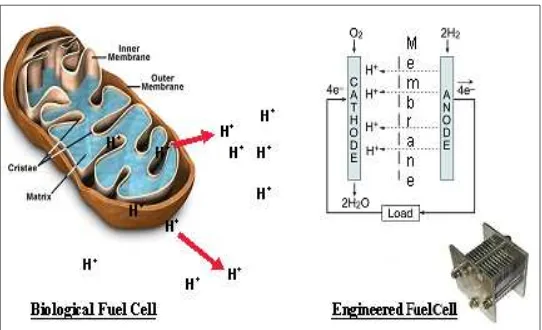Faced with a steady rise in energy costs, dwindling fossil fuel supplies, and a need to maintain a healthy environment—exploration of alternative energy sources has become essential for meeting energy needs. Biological systems employ a variety of eficient ways to collect, store, use, and produce energy. By understanding the basic processes of biological models, scientists may be able to create systems that mimic biomolecules and produce energy in an eficient and cost effective manner. Many advances are already being made in creating artiicial photosynthetic systems and enzyme-based fuel cells, and there are many more biological energy conversion processes to explore.
O
n May 14-15, 2007, a group of chemists, chemical engineers, and others from academia, government, and industry participated in a workshop sponsored by the Chemical Sciences Roundtable to explore how bioinspired chemistry can help solve some of the important energy issues the world faces today. The workshop featured presentations and discussions on the current energy challenges and how to address them, with emphasis on both the fundamental aspects and the robust implementation of bioinspired chemistry for energy. Some key research developments and future research directions were highlighted by the speakers (Box 1).Applying the Fundamentals
Much of the workshop focused on identifying fundamental or basic scientiic aspects of bio -inspired chemistry that can be utilized for energy production. Some of the fundamentals included mimicking photosynthesis and hydrogen-producing enzymes, and using bioinspired catalysts to split water. Thomas Moore of Arizona State University compared and contrasted the chemistry of biological fuel cells (mitochondria) in animals to engineered fuel cells used in vehicles (Figure 1) as an example of a biological system to mimic.
Bioinspired Chemistry For Energy
A Workshop Summary
Permission granted to reproduce this document with no additions or deletions.
Copyright 2008 The National Academy of Sciences Partnerships and Integration
One of the major themes highlighted at the workshop was the need for partnerships and integra-tion between different disciplines and technologies in order to accomplish bioinspired chemistry for energy. The importance of partnerships among companies was discussed. It was noted that smaller companies can beneit by partnering with each other or with larger companies. Henry Bryndza of DuPont stressed the importance of partnerships when he stated, “We really need partnerships…we are partnering in virtually all of these areas for a couple of reasons. One is that we can’t do it all ourselves. The second is that, in some cases, partners bring market-channel access that we don’t have.” Several participants mentioned that it is also important to remember the large infrastructure necessary to effectively utilize bioinspired chemistry
Box 1. Suggestions for Future Research
Several participants indicated areas of research to fur-ther bioinspired chemistry in the energy ield. Some of the research areas mentioned are highlighted below.
• Analyze the complexity of biological systems • Develop instrumentation to allow mechanistic studies with high-time resolution
• Discover new catalysts and new modes of reactivity
• Find new ways to split water into hydrogen and oxygen
• Discover new microbes or thermochemical catalysts for lignin and cellulose conversion • Engineer a catalyst to break carbon-carbon bonds so a direct ethanol fuel cell can be developed • Research fuels created by cyanobacteria grown on non-arable land
• Re-engineer photosynthesis to double or triple its conversion eficiency
• Stabilize enzymes and generate new redox-active compounds and electroactive nanocomposites • Address issues regarding the bioreinery infrastructure
for energy goals, including analytical, computational, and engineering components.
Education and Training
Workshop speakers and participants suggested ways to improve education and training in the area of bioinspired chemistry for energy. Several K-12 and undergraduate education initiatives within industry and government agencies were highlighted, such as the National Science Foundation’s Research Under-graduate Institution Program and the Department of Energy’s summer internship program for high school teachers in laboratories across the country. The group also discussed how graduate education and training could be strengthened to prepare students for work on energy issues in the chemical industries, and how important it is to have a more developed, federally-funded post doctorate fellowship program so post doctorates can participate in energy research. Many participants explained that additional funding would be necessary to improve education and workforce training.
Research Challenges
Research funding gaps were highlighted by vari-ous speakers and participants. Several of the federal agency representatives said that they need additional funding to pursue projects related to bioinspired chemistry for energy. One participant called for a balance between funding basic research and technol-ogy development. Another explained that there is a need for adequate funding in the appropriate agencies, especially those that have a peer-review process for determining how funding is distributed. It was also pointed out that both chemists and biologists need to be adequately funded. Finally, Daniel Nocera of the Massachusetts Institute of Technology said that political forces drive funding, and that sometimes the funding is diverted. He called for an honest broker to represent the energy problem to the public and to de-tail the strategic federal investments needed in energy.
This brief was prepared by the National Research Council based on a workshop organized by the
Chemical Sciences Roundtable, which is funded by the Department of Energy, the National Institutes of Health, and the National Science Foundation. For more information, contact the Board on Chemi-cal Sciences and Technology at (202) 334-2156 or visit http://dels.nas.edu/bcst. Copies of Bioinspired Chemistry for Energy: A Workshop Summary to the Chemical Sciences Roundtable are available from the National Academies Press, 500 Fifth Street, NW, Washington, D.C. 20001; (800) 624-6242; www.nap.edu.
About the Chemical Sciences Roundtable
